Mexican hot sauce isn’t just a condiment—it’s a full-blown flavor adventure. Picture this: fresh tacos piled high, a drizzle of smoky, spicy sauce sliding down the side, and that first bite hitting you with heat, tang, and just the right amount of burn. If that doesn’t get your mouth watering, are you even living?
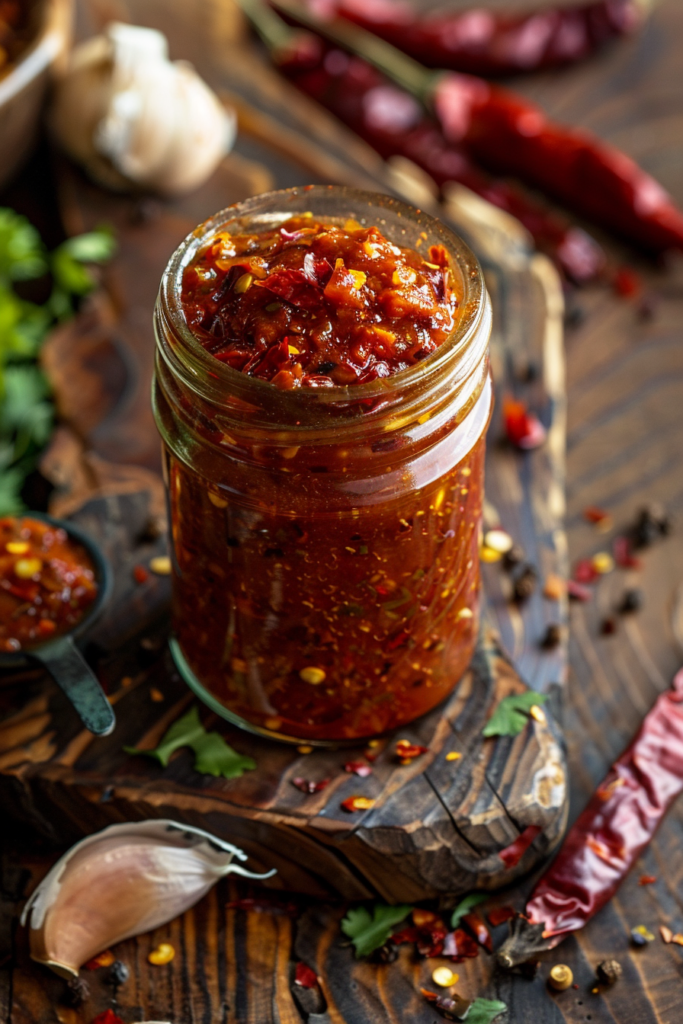
This isn’t the kind of bottled heat you toss in your shopping cart without thinking. Real Mexican hot sauce is a crafted, flavorful blend of dried chiles like guajillo, pasilla, and chile de árbol. And when you toast those chiles just right, mix in a splash of vinegar, garlic, and cumin—something magical happens. You’re not just adding heat; you’re adding soul.
In this article, we’re going deep into the world of Mexican hot sauce. From an authentic homemade recipe to flavor tweaks, chile varieties, expert tips, and must-try brands—you’ll get it all. By the end, you’ll know exactly how to bring that rich, smoky flavor straight to your kitchen table.
Don’t miss our Seafood Boil Sauce for even more spicy goodness.
Table of Contents
The Irresistible Charm of Mexican Hot Sauce
What Makes Mexican Hot Sauce Unique?
What separates Mexican hot sauce from the rest of the spicy crowd? Two words: depth and character. It’s not just about burning your tongue—it’s about layers of flavor. American hot sauces often lean heavy on vinegar with a straightforward spicy kick. Mexican varieties, though? They tell stories with their ingredients.
It starts with dried chiles. Toasted in a dry skillet until aromatic, these peppers develop smoky, earthy tones that build a bold flavor foundation. Blended with garlic, cumin, vinegar, and just a pinch of brown sugar for balance, Mexican hot sauces hit that perfect trifecta: heat, acid, and umami.
Whether you like it mild, medium, or blazing hot, Mexican sauces can flex to match your mood. Plus, it’s wildly versatile—drizzle it on eggs, tacos, grilled meats, even salads. No wonder Mexican tables often feature a bottle or two ready to go, no matter the meal.
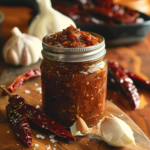
Mexican Hot Sauce
- Total Time: 1h 10 mins
- Yield: 12 servings 1x
Description
A rich, smoky homemade hot sauce made with dried guajillo and pasilla chiles for that true Mexican flavor.
Ingredients
1 dried guajillo chile
1 dried chile negro (pasilla) pepper
2 dried New Mexico chile pods
1 ½ cups warm water
2 cloves garlic, pressed
1 teaspoon ground cumin
1 teaspoon salt
1 teaspoon packed brown sugar
1 teaspoon white vinegar
Instructions
step 1
Remove stems and seeds from the guajillo chile, pasilla chile, and the New Mexico chile pods.
step 2
Heat a cast-iron skillet over medium heat. Toast the chile pods in the skillet until lightly brown, about 2 to 3 minutes. Transfer the chile pods to a small bowl and pour the warm water over them. Allow chiles to soak about 40 minutes.
step 3
Remove the guajillo and New Mexico chiles from the water. Use a spoon to scrape the pulp from the skin. Discard the skin. Place the pulp of the guajillo chile and the New Mexico chiles in a food processor with the pasilla chile and the water in which the peppers soaked. Puree in the food processor until all ingredients are combined. Add the garlic, cumin, salt, brown sugar, salt, and vinegar. Puree the mixture until smooth.
- Prep Time: 30 mins
- Cook Time: 40 mins
Nutrition
- Calories: 5
- Fat: 0g
- Carbohydrates: 1g
- Protein: 0g
A Brief History of Mexican Hot Sauce Traditions
The roots of Mexican hot sauce stretch deep into the past. For over 6,000 years, chiles have been at the heart of Mexican cooking. Ancient cultures like the Aztecs and Mayans used chiles in everything from cooking to medicine to trade. These peppers weren’t just food—they were power.
But it was the introduction of vinegar by Spanish colonizers that transformed chile pastes into the hot sauces we know today. Vinegar acted as a preservative and flavor booster, helping to balance the intense heat of dried peppers like pasilla, guajillo, and chile de árbol.
Different regions of Mexico began developing their own unique sauce styles. Veracruz brought zesty, citrus-forward sauces, while Oaxaca went for deep, smoky blends. The northern regions kept it simple—just chiles, salt, and heat. No matter the variation, the tradition stayed the same: bold flavors that bring every dish to life.
Learn more about Soy Sauce and Gluten Free and how they differ by state.
Authentic Mexican Hot Sauce Recipe
Ingredients You’ll Need for Authentic Flavor
Making your own Mexican hot sauce at home is easier than you might think. The secret is using high-quality dried chiles and balancing the heat with acidity and a touch of sweetness. This recipe gives you that taco stand flavor you crave, straight from your own kitchen.
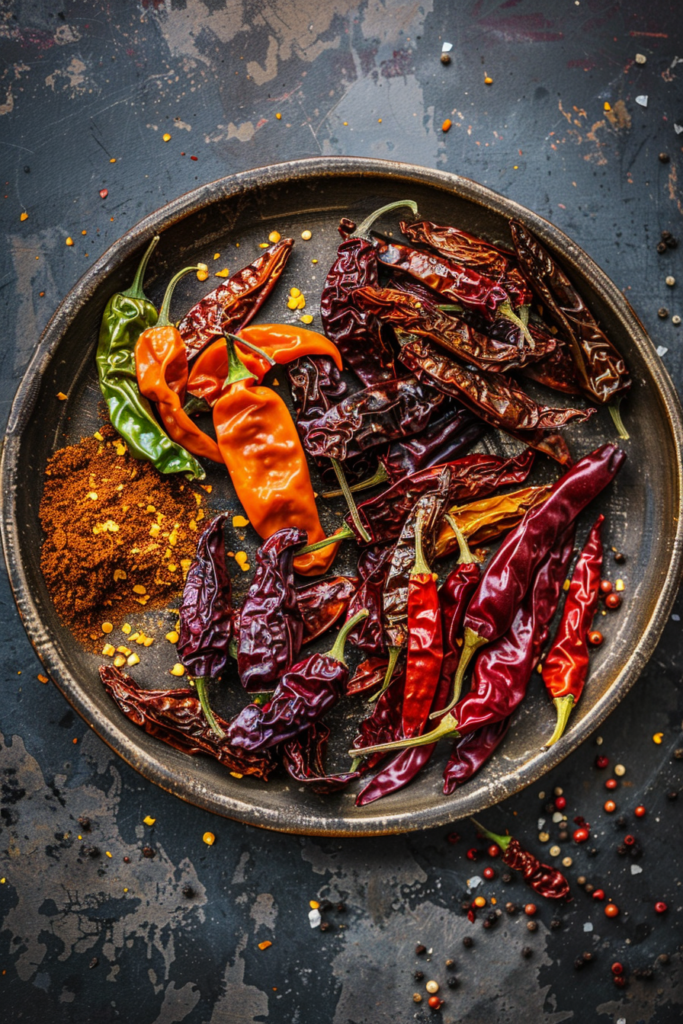
Here’s exactly what you’ll need to get started:
| Ingredient | Amount | Purpose |
|---|---|---|
| Dried guajillo chile | 1 | Adds mild, smoky flavor |
| Dried chile negro (pasilla) | 1 | Brings earthy undertones |
| Dried New Mexico chiles | 2 | Adds rich color and heat |
| Warm water | 1 ½ cups | For soaking the chiles |
| Garlic cloves | 2, pressed | Provides aromatic flavor |
| Ground cumin | 1 teaspoon | Earthy, warming spice |
| Salt | 1 teaspoon | Balances and enhances flavor |
| Brown sugar | 1 teaspoon | Subtle sweetness |
| White vinegar | 1 teaspoon | Adds tang and preserves |
Optional:
Want it hotter? Add a couple of dried chile de árbol or splash in lime juice for more tang.
Step-by-Step Preparation Method
Now, let’s get to the fun part: making your Mexican hot sauce. Follow these steps carefully, and you’ll be ladling it over everything in no time.
Step 1: Prep the Chiles
Take off the stems and shake out the seeds from all your dried chiles. This prevents excessive bitterness and gives a smoother sauce.
Step 2: Toast for Flavor
Heat a dry cast-iron skillet over medium heat. Toast the dried chiles for about 2-3 minutes, turning frequently until they become fragrant. Be careful not to burn them—just a gentle char is all you need.
Step 3: Soak and Soften
Transfer the toasted chiles to a bowl and cover them with 1½ cups of warm water. Let them soak for about 40 minutes to soften fully.
Step 4: Scrape and Blend
Take out the guajillo and New Mexico chiles from the soaking water. Scrape out the softened pulp with a spoon, discarding the tough skins. Add the pulp, soaking water, and pasilla chile to a blender or food processor.
Step 5: Add the Flavor
Add garlic, cumin, salt, brown sugar, and vinegar into the mix. Blend until completely smooth. If it’s too thick for your liking, splash in a bit of water or vinegar until you get your desired consistency.
Step 6: Adjust and Enjoy
Taste your hot sauce. Need more heat? Blend in a dried chile de árbol. Prefer a tangier bite? Squeeze in some lime juice. Once it’s perfect, pour it into a jar and store in the fridge.
Pro Tip: This sauce improves after a day or two as the flavors meld together.
Choosing the Right Chiles for Your Sauce
Mild, Medium, and Hot: Types of Mexican Dried Chiles
One of the secrets behind every legendary Mexican hot sauce is the careful choice of chiles. Not all chiles are created equal, and the ones you choose will shape the flavor, aroma, and heat of your sauce.
Here’s a quick guide to help you pick:
| Chile Name | Heat Level | Flavor Profile | Best For |
|---|---|---|---|
| Guajillo | Mild to medium | Smoky, tangy, slightly sweet | Everyday hot sauces, enchiladas |
| Pasilla (Negro) | Mild | Earthy, raisin-like | Mole sauces, smoky hot sauces |
| New Mexico | Medium | Bright, slightly sweet | Hot sauces, stews |
| Ancho | Mild to medium | Sweet, smoky, chocolatey | Mild hot sauces, mole |
| Chile de Árbol | Hot | Sharp, fiery | Extra heat, chili oil |
| Chipotle | Medium to hot | Smoky, rich | BBQ sauces, thick hot sauces |
Need it hotter? Toss in a few chile de árbol. Looking for complexity? Combine two or three types.
Flavor Profiles of Popular Mexican Chiles
Let’s break down why these specific chiles work so well in hot sauces:
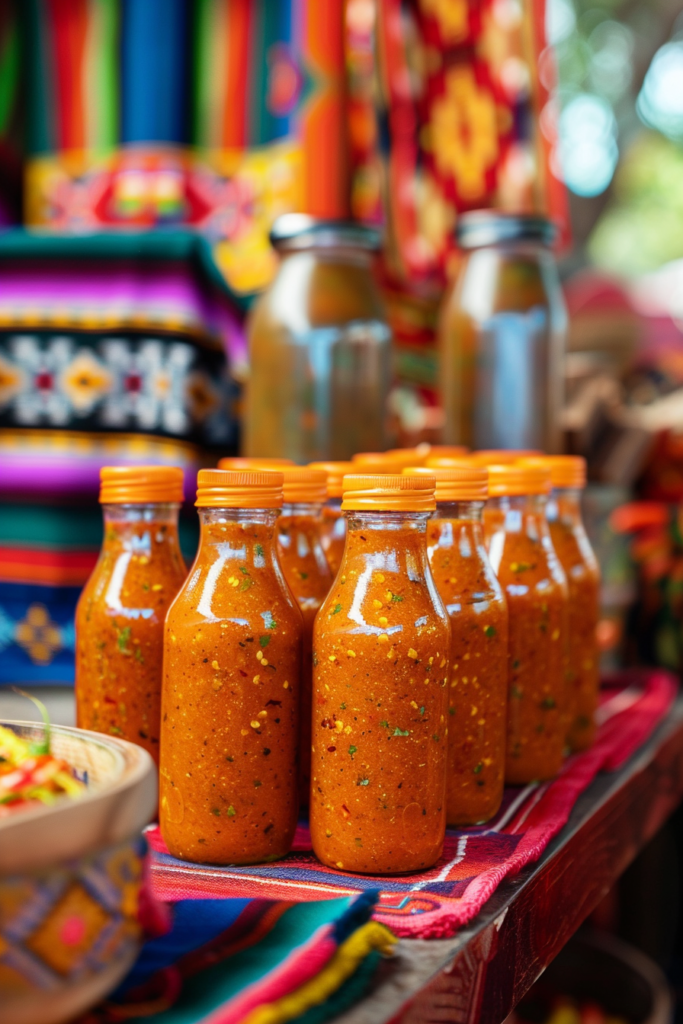
Guajillo Peppers:
These red beauties are mild enough for everyone but add a rich, slightly fruity undertone. Perfect for an everyday drizzle.
Pasilla Chiles:
Known for their earthy depth, pasilla adds body and smoothness. They’re the secret behind sauces that feel hearty and satisfying.
New Mexico Chiles:
With their bright red color and subtle heat, they make your sauce look good and taste balanced. Their flavor falls somewhere between smoky and mildly sweet.
Chile de Árbol:
Tiny but fierce. A little goes a long way. Use these when you want your Mexican hot sauce to deliver serious spice.
Chipotle Chiles (Optional):
Smoked and dried jalapeños, these bring a deep, BBQ-like flavor with a medium burn. If you like your sauces smoky, this one’s your friend.
By understanding your peppers, you’re already halfway to creating a killer sauce.
Flavor Variations of Mexican Hot Sauce
Smoky, Tangy, and Sweet: Adjusting the Flavor to Your Taste
One of the best things about making Mexican hot sauce at home is how flexible it is. You don’t have to stick to just one flavor profile. Like it smoky? Prefer a tangy punch? Craving a hint of sweetness? It’s all possible with just a few tweaks.
Here’s how to build the flavor your way:
For a Smokier Flavor:
- Add a couple of chipotle chiles to the blend.
- Toast your dried chiles for a little longer (but don’t burn them) to deepen the smoky aroma.
- Stir in a teaspoon of smoked paprika for a subtle kick.
For a Tangy Finish:
- Add the juice of 1 fresh lime after blending.
- Use apple cider vinegar instead of plain white vinegar for more fruity acidity.
For Sweet and Spicy Balance:
- Increase the brown sugar by ½ to 1 teaspoon.
- For natural sweetness with a twist, add a roasted red bell pepper into the blender.
Pro tip: If your sauce turns out too bitter, it’s usually because the chiles were toasted too much or the seeds weren’t removed. Always deseed dried chiles before toasting unless you’re chasing extreme heat.
Creative Additions to Spice Things Up
Now that you’ve got your flavor dialed in, why not take it up a notch with a few creative ingredients? These additions turn a good hot sauce into a legendary one:
- Roasted Garlic: Roasting the garlic before blending gives your sauce a rich, caramelized flavor.
- Tomato Paste: Helps thicken the sauce and adds a savory umami kick.
- Onion Powder or Fresh Onion: Boosts flavor depth without adding too much moisture.
- Dried Oregano: A pinch of Mexican oregano works wonders, giving your hot sauce herbal brightness.
- Fresh Cilantro (Optional): For fresh, green flavors, blend in a handful at the end.
Whether you’re drizzling it on grilled meats, folding it into stews, or just dipping tortilla chips into it straight, the right tweaks make Mexican hot sauce an extension of your own taste.
How to Store and Preserve Mexican Hot Sauce
Short-Term Storage: Fridge Tips
You’ve made a delicious batch of Mexican hot sauce—now, how do you keep it fresh and full of flavor?
For short-term storage, your refrigerator is your best friend. Here’s how to do it right:
- Use Glass Jars or Bottles: Avoid plastic containers, as they can absorb smells and stain from the chiles. Opt for glass with a tight-fitting lid.
- Label and Date: Always label your jars with the date you made the sauce. Homemade sauces usually stay fresh for up to 2 weeks in the fridge.
- Shake Before Use: Because the sauce doesn’t contain preservatives like commercial varieties, natural separation is normal. Just give it a good shake before pouring.
Want to extend that shelf life a little? Adding an extra splash of vinegar (about 1 tablespoon per cup) boosts acidity and keeps the sauce fresher for longer.
Long-Term Storage: Canning and Freezing Methods
If you’ve made a big batch of Mexican hot sauce or want to save some for later use, long-term storage methods come in handy. Here’s how to do it safely:
Freezing:
- Pour the sauce into ice cube trays, freeze it, then transfer the cubes to a zip-top freezer bag for storage. This lets you thaw small portions as needed.
- Frozen hot sauce keeps well for 3-4 months.
Canning (Advanced):
- Sterilize canning jars and lids.
- Heat the sauce before filling the jars.
- Process in a hot water bath for 10-15 minutes.
- Properly canned hot sauce can last up to 12 months if stored in a cool, dark place.
Warning: Canning is best suited for hot sauces that are highly acidic. Always follow safe canning practices or consult reliable sources for proper preservation.
By following these storage tips, you can keep your homemade Mexican hot sauce tasting fresh and ready to spice up any dish whenever the craving strikes.
Best Dishes to Pair with Mexican Hot Sauce
Mexican Dishes: Tacos, Enchiladas, and More
When it comes to pairing food with Mexican hot sauce, tacos are just the beginning. The bold, smoky flavors of homemade hot sauce work beautifully across all types of Mexican cuisine. Here’s where you should start:
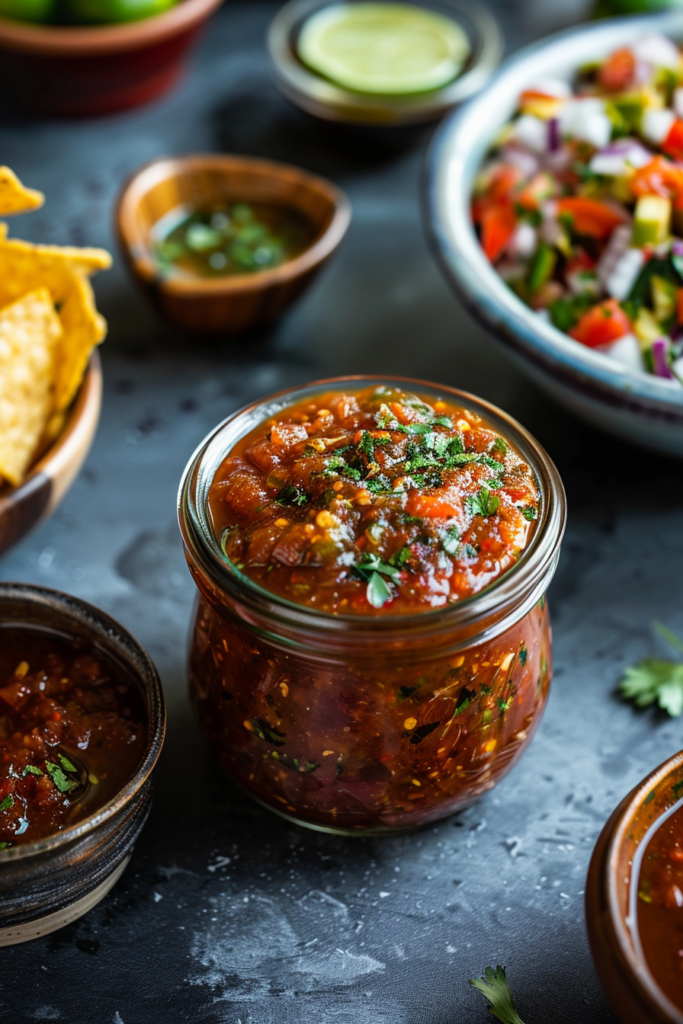
- Tacos: Whether it’s carne asada, carnitas, or grilled veggies, a drizzle of hot sauce brings tacos to life.
- Enchiladas: Spoon hot sauce over enchiladas before baking for a spicy, flavorful punch.
- Quesadillas: Cut those cheesy triangles and dip them right into a small bowl of homemade hot sauce—simple, yet unbeatable.
- Huevos Rancheros: Nothing wakes you up like eggs topped with salsa, tortillas, and a good hit of spicy sauce.
- Chilaquiles: Breakfast gets a fiery makeover with tortilla chips smothered in red sauce and topped with crema, cheese, and eggs.
- Tamales: Add a spoonful of your hot sauce on the side or drizzle over tamales before each bite for a smoky, tangy contrast.
These pairings aren’t just traditional—they’re legendary.
American Favorites That Taste Better with Mexican Hot Sauce
Think Mexican hot sauce only belongs on Mexican dishes? Think again. This stuff is a secret weapon for elevating everyday meals.
- Scrambled Eggs or Omelets: Hot sauce + eggs = a morning win.
- Grilled Cheese Sandwich: Yep—dip or drizzle for an instant flavor upgrade.
- Macaroni and Cheese: Take that creamy comfort food and kick it up a notch.
- Burgers and Hot Dogs: Forget ketchup. A spoonful of spicy sauce brings gourmet flavor to backyard grilling.
- Pizza: Next time you’re reaching for crushed red pepper flakes, swap in your homemade hot sauce.
- French Fries: Better than ketchup. Seriously.
The truth is, Mexican hot sauce doesn’t just fit—it elevates. No matter what’s on your plate, a spicy drizzle transforms the ordinary into unforgettable.
PART 8: FAQs About Mexican Hot Sauce
What’s the most popular hot sauce in Mexico?
Valentina is widely considered the most popular hot sauce in Mexico. Its mild heat, thicker texture, and balanced flavor make it a favorite on everything from tacos to popcorn.
What is Mexican hot sauce called?
In Mexico, hot sauce is typically called “salsa picante”. You’ll also hear names like salsa roja (red sauce) or salsa verde (green sauce) depending on the type.
What is the famous Mexican sauce?
While Cholula is one of the most famous bottled Mexican hot sauces internationally, Mexico’s culinary world is also famous for mole poblano, a rich, spiced sauce used in traditional dishes.
How spicy is Tapatío hot sauce?
Tapatío measures around 3,000 Scoville Heat Units (SHU), offering a pleasant medium heat perfect for eggs, pizza, and soups.
Conclusion and Final Tips for Hot Sauce Lovers
Mexican hot sauce isn’t just a topping—it’s a tradition, a story, and a bold expression of flavor in every drop. Whether you’re crafting your own with dried guajillo and pasilla chiles or reaching for a trusty bottle of Valentina, you’re embracing centuries of culinary heritage.
The beauty of this sauce is its versatility. Want it smoky? Add chipotle. Need more heat? Toss in some chile de árbol. Prefer a tangy bite? Lime juice and vinegar do the trick. And don’t forget—homemade hot sauce gets better after a day or two in the fridge.
No matter where you’re starting—whether you’re a spice fanatic or just testing the waters—Mexican hot sauce deserves a permanent spot in your kitchen lineup.
Find more delicious recipes on GrandyRecipes’ Pinterest, and stay inspired with the newest tips and ideas by following GrandyRecipes on Facebook.
